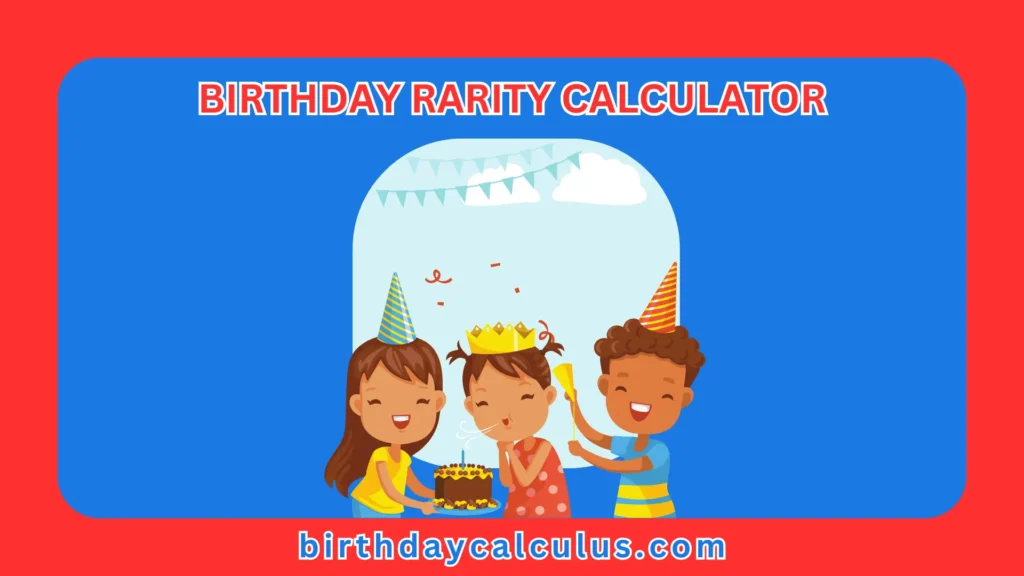Birthday Rarity Calculator
Find out how rare your birthday is!

Birthday Rarity Calculator
A Birthday Rarity Calculator is an interactive tool designed to determine how common or rare your birthday is compared to other dates throughout the year. This fascinating birthday rarity calculator provides insights into birth date frequencies, allowing users to discover interesting facts about their birthdays. Whether you’re curious about your birthday’s rarity or interested in demographic trends, this guide will walk you through Birthday Rarity Calculators’ concepts, calculations, and applications.
Key Concepts and Terminology
Before diving into the calculations, let’s familiarize ourselves with some key terms:
- Birth date frequency: The number of births occurring on a specific date.
- Birthday distribution: The pattern of birth frequencies across all days of the year.
- Rarity rank: A measure of how uncommon a birthday is compared to others.
- Birth data: Statistical information about birth rates and patterns.
- Leap day: February 29th occurs every four years in leap years.
- Holiday effect: The influence of holidays on birth rates.
Rarity Birthday Calculator: Calculations and Methods
Basic Probability Calculation
The simplest method to calculate birthday rarity assumes an equal distribution of birthdays throughout the year:
P(specific birthday) = 1 / 365 ≈ 0.27% (excluding leap years)
However, this approach doesn’t account for real-world variations in birth rates.
Data-Driven Calculation
A more accurate method uses historical birth data to calculate rarity:
- Collect birth data for each day of the year.
- Calculate the total number of births in the dataset.
- For each date, calculate its frequency:
- Frequency(date) = Number of births on date / Total births
- Rank dates from most common to rarest.
- Calculate percentile rank for each date:
- Percentile Rank = (Number of dates with lower frequency / Total dates) * 100
Visualization: Birthday Heatmap
Here’s a simplified representation of a birthday heatmap:
Jan Feb Mar Apr May Jun Jul Aug Sep Oct Nov Dec.
This heatmap visually represents birth frequency, with darker colors indicating more common birthdays.
How Rare is My Birthday: Detailed Example

Let’s calculate the rarity of July 4th (a notable holiday in the US) using hypothetical data:
Given:
- Total births in the dataset: 1,000,000
- Births on July 4th: 2,500
- Days with fewer births: 280
Step 1: Calculate frequency Frequency(July 4th) = 2,500 / 1,000,000 = 0.25%
Step 2: Calculate percentile rank Percentile Rank = (280 / 365) * 100 ≈ 76.71

Interpretation: July 4th is rarer than 76.71% of all birthdays, likely due to the holiday effect.
Alternative Approaches
Zodiac Sign Integration
Some calculators incorporate astrological elements:
- Determine zodiac signs based on birth date.
- Calculate rarity within each zodiac sign.
- Compare rarity across different signs.
International Comparisons
Advanced birthday rarity calculators may use data from multiple countries:
- Collect birth data from various nations.
- Calculate the rarity for each country.
- Compare international birthday trends.
Using a Birthday Rarity Calculator
Follow these steps to use a typical online Birthday Rarity Calculator:
- Open the calculator website.
- Enter your birth date (month, day, year).
- Click the “Calculate” button.
- View your results.
Practical Tips and Considerations
- Data accuracy: Ensure the calculator uses recent, reliable birth data.
- Leap year awareness: Check if the calculator accounts for February 29th.
- Regional variations: Consider how holidays and seasons affect birth rates in different locations.
- Historical context: Be aware that birth patterns change due to medical advancements and cultural shifts.
- Privacy: Use calculators that don’t store personal information.
Frequently Asked Questions
Why is my birthday rarer than I expected?
Holidays, weekends, and seasonal factors can influence birth rates, making some dates rarer than others.
How often is the data updated in these calculators?
It varies by calculator. Check for information about data sources and update frequency on the website.
Can Birthday Rarity Calculators predict future birth trends?
While they can’t predict with certainty, they can provide insights into historical patterns that may influence future trends.
Are birthdays equally distributed throughout the year?
No, birth rates vary due to factors like seasons, holidays, and cultural events.
How does leap day (February 29th) affect birthday rarity calculations?
Leap day birthdays are typically considered separately due to their four-year cycle, often ranking as the rarest birthday.
Related Topics and Tools
Conclusion
By understanding the concepts behind Birthday Rarity Calculators, you can gain fascinating insights into your birthday and broader demographic trends. Whether planning a party, conducting research, or simply satisfying your curiosity, these tools offer a unique perspective on the day you were born.
